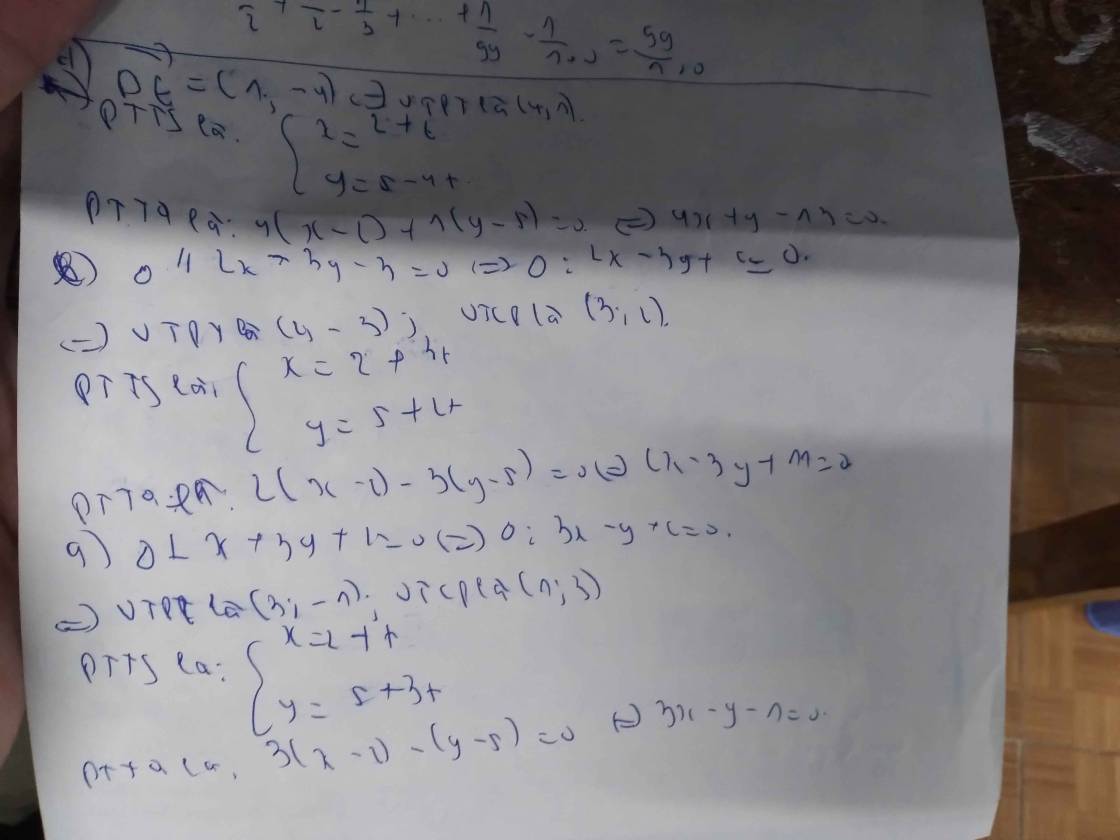Hãy nhập câu hỏi của bạn vào đây, nếu là tài khoản VIP, bạn sẽ được ưu tiên trả lời.

1: Theo đề, ta có hệ phương trình:
\(\left\{{}\begin{matrix}3a+b=-2\\2a+b=1\end{matrix}\right.\Leftrightarrow\left\{{}\begin{matrix}a=-3\\b=1-2a=1-2\cdot\left(-3\right)=7\end{matrix}\right.\)
2: Vì (d)//y=-3x+2 nên a=-3
Vậy: y=-3x+b
Thay x=3 và y=3 vào y=-3x+b, ta được:
b-9=3
hay b=12

a: Vì (d) vuông góc với (Δ) nên -a=-1
hay a=1
Vậy: (d): y=x+b
Thay x=1 và y=-5 vào (d), ta được: b+1=-5
hay b=-6
b: Tọa độ giao điểm là:
\(\left\{{}\begin{matrix}5x^2+4x+3=-3x+3\\y=-3x+3\end{matrix}\right.\Leftrightarrow\left\{{}\begin{matrix}x\left(5x+7\right)=0\\y=-3x+3\end{matrix}\right.\)
\(\Leftrightarrow\left(x,y\right)\in\left\{\left(0;3\right);\left(-\dfrac{7}{5};\dfrac{36}{5}\right)\right\}\)

a) Gọi đường tròn cần tìm là \(\left(C\right):x^2+y^2-2ax-2by+c=0\)
\(A\left(-1;1\right)\in\left(C\right)\Rightarrow1+1+2a-2b+c=0\Rightarrow2a-2b+c=-2\)
\(B\left(3;1\right)\in\left(C\right)\Rightarrow9+1-6a-2b+c=0\Rightarrow-6a-2b+c=-10\)
\(C\left(1;3\right)\in\left(C\right)\Rightarrow1+9-2a-6b+c=0\Rightarrow-2a-6b+c=-10\)
Giải hệ phương trình ta được: \(a=1;b=1;c=-2\)
Vậy đường tròn cần tìm là: \(x^2+y^2-2x-2y-2=0\)
b) Ta có \(\left(C\right):x^2+y^2-4x+6y+3=0\)
\(\Rightarrow a=\dfrac{-4}{-2}=2;b=\dfrac{6}{-2}=-3;c=3\)
\(\Rightarrow I\left(2;-3\right)\) là tâm, bán kính \(R=\sqrt{2^2+\left(-3\right)^2-3}=\sqrt{10}\)
Để \(\left(\Delta\right)\) tiếp xúc đường tròn \(\Leftrightarrow d\left(I;\Delta\right)=R\)
\(\Leftrightarrow\dfrac{\left|9+m\right|}{\sqrt{10}}=\sqrt{10}\Leftrightarrow\left|9+m\right|=10\Leftrightarrow\left[{}\begin{matrix}9+m=10\\9+m=-10\end{matrix}\right.\Leftrightarrow\left[{}\begin{matrix}m=1\\m=-19\end{matrix}\right.\)

a.
\(\overrightarrow{AB}=\left(3;-4\right)\Rightarrow\) đường thẳng AB nhận (4;3) là 1 vtpt
Phương trình AB:
\(4\left(x-2\right)+3\left(y-5\right)=0\Leftrightarrow4x+3y-23=0\)b.
Do d vuông góc delta nên d nhận (4;-3) là 1 vtpt
Phương trình d có dạng: \(4x-3y+c=0\)
\(d\left(B;d\right)=\dfrac{\left|4.5-3.1+c\right|}{\sqrt{4^2+\left(-3\right)^2}}=\dfrac{1}{5}\)
\(\Rightarrow\left|c+17\right|=1\Rightarrow\left[{}\begin{matrix}c=-16\\c=-18\end{matrix}\right.\)
Có 2 đường thẳng d thỏa mãn: \(\left[{}\begin{matrix}4x-3y-16=0\\4x-3y-18=0\end{matrix}\right.\)

a: (Δ)//d nên Δ: -x+2y+c=0
=>VTPT là (-1;2)
=>VTCP là (2;1)
PTTS là:
x=3+2t và y=1+t
b: (d): -x+2y+1=0
=>Δ: 2x+y+c=0
Thay x=4 và y=-2 vào Δ, ta được:
c+8-2=0
=>c=-6




Δ vuông góc với d:3x-y+7=0
=>Δ: x+3y+c=0
Thay x=1 và y=5 vào Δ, ta được:
\(c+1+3\cdot5=0\)
=>c+16=0
=>c=-16
=>Δ: x+3y-16=0
M thuộc Ox nên M(x;0)
\(d\left(M;\text{Δ}\right)=3\)
=>\(\dfrac{\left|x\cdot1+0\cdot3-16\right|}{\sqrt{1^2+3^2}}=3\)
=>\(\left|x-16\right|=3\sqrt{10}\)
=>\(\left[{}\begin{matrix}x-16=3\sqrt{10}\\x-16=-3\sqrt{10}\end{matrix}\right.\Leftrightarrow\left[{}\begin{matrix}x=16+3\sqrt{10}\\x=16-3\sqrt{10}\end{matrix}\right.\)
vậy: \(M\left(16+3\sqrt{10};0\right);M\left(16-3\sqrt{10};0\right)\)